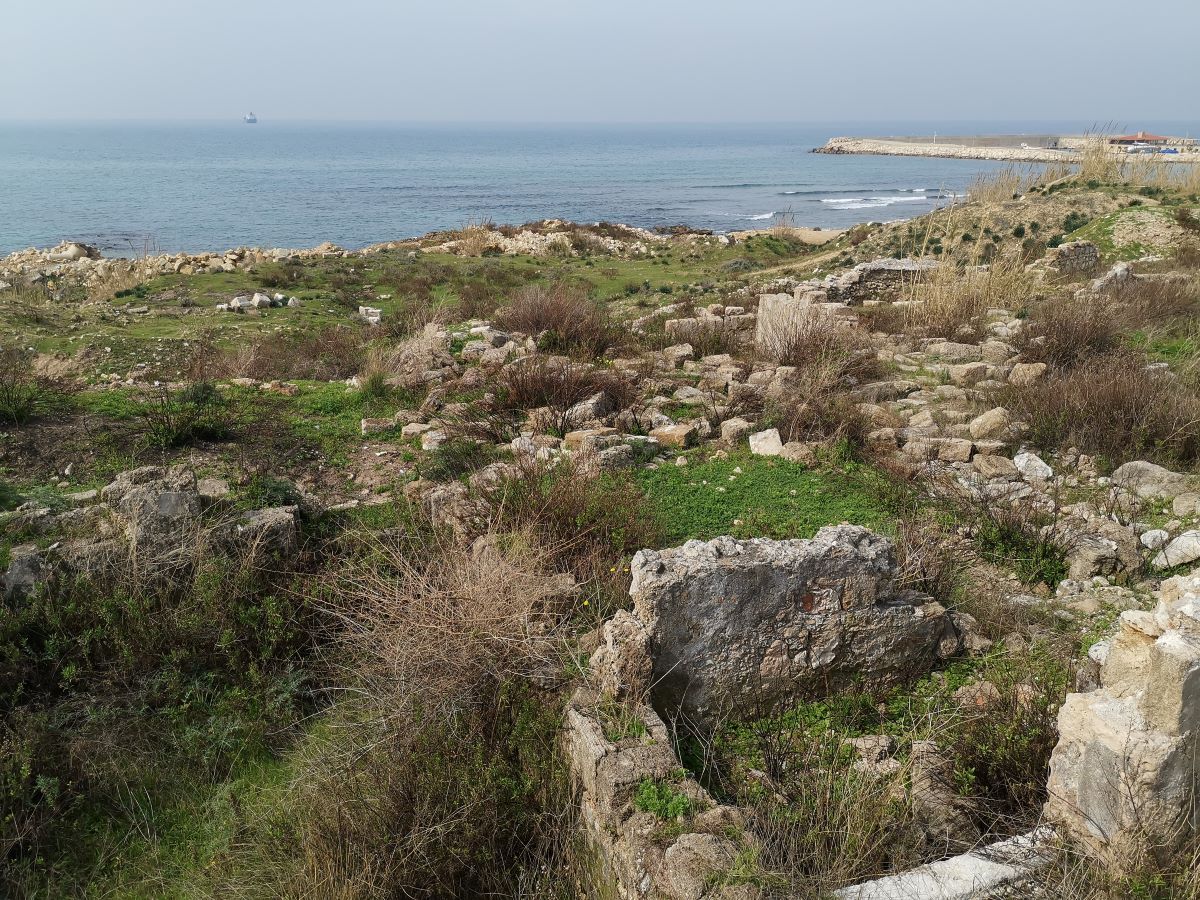Jiyeh houses a Phoenician era settlement that testifies to a significant human occupation classical antiquity era.
Toponym
The ancient locality of Jiyeh was known under several designations:
uruGi was the name of the settlement mentioned in an inscription by the Assyrian king Esarhaddon which contains the list of sixteen cities belonging to the territory of Sidon, conquered in 676 BC.
Porphyreon Polis (City of Porphyreon) – was a 4th century BC Greek designation mentioned in the Periplus of Pseudo-Scylax (a periplus describing the sea route around the Mediterranean and the Black Sea).
Porphyreon may refer to the murex purple color of the pigment taken from the shell of mollusks belonging to the species of murex trunculus and brandaris. Despite this etymology, during the archaeological excavations carried out in Jiyeh, no trace of workshops producing this noble pigment has been found so far.
The designation was also mentioned in The Histories of Polybius. The Greek historian evokes the preparations for a battle that took place in 218 BC between the Seleucid army of Antiochos III and the Lagid army of Ptolemy IV: The troops clashed south of Porphyreon, where the strip of land between the coast and the mountain narrows to form a small cape (where the power plant of Jiyeh is located nowadays).
The mutatio Parphirion is a Byzantine-era designation given to the settlement as mentioned in the Itinerarium Burdigalense (Bordeaux Pilgrim’s Route) dated in the year 333 AD. Mutatio Parphirion may refer to the city as a stage where pilgrims would stop to rest before continuing their journey to the holy land.
The Nabi Younes site, a 19th century designation given to the locality based on a local tradition associated with the Wéli of the prophet Jonah, which consequently saw the construction of a mosque in the village.
The history of the settlement cannot be retraced due to the lack of historical records in the ancient chronicles.
Settlement
The site of Jiyeh was excavated several times between 1975 and 2015. What remains of the settlement covers a total area of approximately 40mx50m. Studies and findings revealed that the settlement was inhabited between the mid 1st millennium BC and the 7th century AD. It also revealed that the economy of the settlement was based on ceramic production, cultivation, fishing and mammal husbandry.
What can be observed today are Roman and Byzantine era structural elements:
Houses – several houses consisting of four to nine rooms were unearthed, built from local sandstone. Most of the rooms were plastered and had windows, doors and floors, including stone, lime and mosaic flooring. The houses were connected through small streets and the settlement was bordered by walls measuring up to 2 meters height; it also had a sewage system. Bread ovens were found in two houses, which suggest that a bakery existed to supply the residents.
Basilica – A Byzantine era basilica was unearthed at the western part of the site, measuring about 30mx20m. Its mosaic pavement was removed and conserved at the Mosaic Museum in Beit El Dine. An inscription on the mosaic dates the construction of the basilica to 506 AD.
Artifacts – Stone ashlars with paintings on them were discovered during excavations. It contains red inscriptions written in Greek on white plaster, as well as Christian formulas, floral and figural representations, and also people working in the field or saints with halos. Other elements were discovered such as the remnants of oil lamps, bronze bowls and bells, locks, clay jars and fishing gears, and coins dating back to the 2nd and 3rd century BC.
Necropolis – Salvage excavations in Jiyeh in 2004–05 uncovered a necropolis with 27 tombs representing several burial types. The construction of a holiday resort in this area resulted in the destruction of most of the necropolis.
Workshops – the 3rd century BC era workshops was located right next to the necropolis. The main production was ceramic and amphora jars. It is important to note that both the necropolis and the workshops are located less than 1 km north of the settlement.
**You must contact the municipality of Jiyeh to get a visit approval**
Karim Sokhn
Tour Operator & Tour Guide
References
Grave Monuments from Jiyeh (Porphyreon) and the Sepulchral Artof Sidon’s Chorra.
Mosaics from Jiyeh/Porphyreon in Lebanon: the universality of mosaic art in late antiquity.
Preliminary report on the 2010 excavation seasonat Jiyeh (Porphyreon). Tomasz Waliszewski, Mariusz Gwiazda
Fishing gear from Jiyeh (Porphyreon), preliminary report. PolishArchaeology in the Mediterranean 22 (Research 2010), 2013.
Jiyeh(Porphyreon). Nouvelles découvertes sur le territoire de Sidon à l’époquehellénistique Tomasz Waliszewski, Urszula Wicenciak.
Mammals in the economy of ancient Porphyreon (Lebanon),Joanna Piątkowska-Małecka, Institute of Archaeology, University of Warsaw.
Iiyeh (Porphyreon) 1975 excavation season. Roger Saidah’sarchaeological works in the residential sector D, SSUE 50-51 Autumn-Spring2019-20, pp. 164-198 .
Preliminary results of a stratigraphic analysis of late Romanand early Byzantine architecture in the residential quarter of Jiyeh, michał Dzik,Institute of Archaeology, University of Rzeszów.







